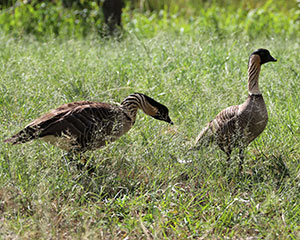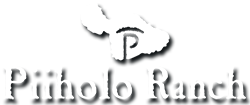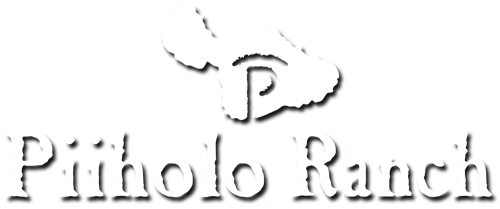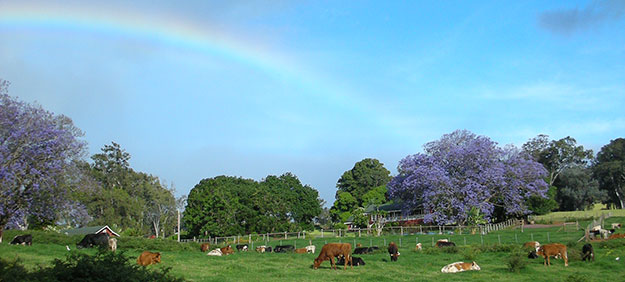Eco System
As you drive from the picturesque paniolo town of Makawao to the “edge of the forest” (translation of Makawao), you will notice along the narrow, winding curves of Piiholo Road that the flora becomes lush and the trees more magnificent and dense. While visiting Piiholo Ranch, located on the edge of the Makawao Forest Reserve, you will be able to see many of the native and indigenous plants of Hawaii, and at times, glimpse the colorful endemic forest birds. If you can imagine, at one time in the Hawaiian Islands the riot of color of the birds’ feathers rivaled that of the tree’s bright blossoms. Click below for information about native Hawaiian plants and wildlife, and Piiholo Ranch’s dedication to preserve the splendor and vitality of this incredible yet fragile area of Maui.
Koa Acacia Tree
The stately Koa acacia tree, which provides Hawaii’s prized hardwood, made its home here with its sunshine yellow mini-pompon flowers. Majestic ‘Ohi‘a lehua trees, which boast beautiful crimson pin cushion-like flowers, lined the mountain tops. On Maui, sawmills produced lumber at Ka‘ili‘ili (also known as Piiholo) in the forests above Makawao, beginning in 1860 and continuing for 20 years. This practice almost totally depleted the land of its Koa and ‘Ohi‘a. By the turn of the 20th century, this mill was reduced to providing firewood for the lowland sugar plantations. When the Koa forests were gone, the guava trees started taking over, many of which you’ll still see today. Around 1918, Sam Baldwin began clearing the guava so that the ranch could properly graze these lands.
Native Bushes
 Along the Piiholo Ranch gulches, we will point out native bushes, such as Pukiawe and Kopiko (in the coffee family), verdant ferns, like the Hapu‘u, prolific Ama‘u, Uluhe, Kupukupu, and Palapalai (used by hula dancers). In our deep gulches, we’ve found Wauke (used for making tapa cloth). Some biologists have told us they have seldom seen it growing in the wild. There is also Halapepe (sacred to hula), Iholena (The Banana), Hoi (The Bitter Yam), the Hawaiian yam and some taro. You’ll also see Manono, a small tree belonging to the coffee family, and makaloa which was used for making woven mats.
Along the Piiholo Ranch gulches, we will point out native bushes, such as Pukiawe and Kopiko (in the coffee family), verdant ferns, like the Hapu‘u, prolific Ama‘u, Uluhe, Kupukupu, and Palapalai (used by hula dancers). In our deep gulches, we’ve found Wauke (used for making tapa cloth). Some biologists have told us they have seldom seen it growing in the wild. There is also Halapepe (sacred to hula), Iholena (The Banana), Hoi (The Bitter Yam), the Hawaiian yam and some taro. You’ll also see Manono, a small tree belonging to the coffee family, and makaloa which was used for making woven mats.
Nene Geese
 You may have heard of Hawaii’s celebrated Nene geese, who were re-introduced to Haleakala National Park about 40 years ago as they were nonexistent on Maui. The Nene is Hawaii’s State Bird, and you may soon see them at Piiholo. Other forest birds which are native to the slopes of Haleakala can be viewed in our back ranch: Kolea, the yellow plover that migrates from Alaska each year, and the scarlet red ‘Apapane (honeycreeper). Keep a good eye out for the elusive native Dragon Fly and delicate Damsel Fly, as well as the endangered native Hawaiian Bats, which may come out from their den late in the afternoon. Piiholo enjoys one of the few bat habitats on the island.
You may have heard of Hawaii’s celebrated Nene geese, who were re-introduced to Haleakala National Park about 40 years ago as they were nonexistent on Maui. The Nene is Hawaii’s State Bird, and you may soon see them at Piiholo. Other forest birds which are native to the slopes of Haleakala can be viewed in our back ranch: Kolea, the yellow plover that migrates from Alaska each year, and the scarlet red ‘Apapane (honeycreeper). Keep a good eye out for the elusive native Dragon Fly and delicate Damsel Fly, as well as the endangered native Hawaiian Bats, which may come out from their den late in the afternoon. Piiholo enjoys one of the few bat habitats on the island.
Piiholo’s Preservation Efforts
The Baldwin Family has invited some of Hawaii’s leading Botanists and Biologists to Piiholo. Having conducted informal biological surveys, they have pointed out the tremendous opportunities for protection of many of the species of plants and birds that co-exist here. As a result, Piiholo Ranch is embarking on several programs for the preservation, protection, and enhancement of Hawaii’s fragile eco-systems so that future generations can enjoy they abundant beauty as much as we do. While visiting we’d like to share them with you, our guests, so you can join in our enthusiasm for preserving them.





